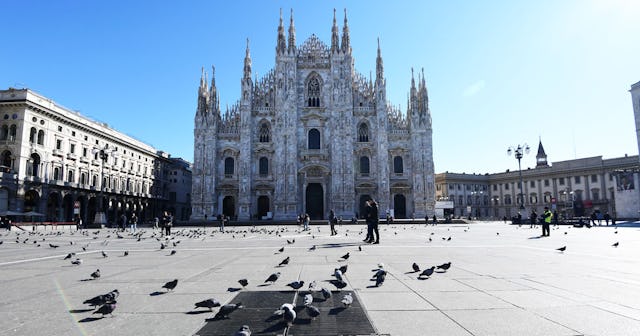Social Distancing Is A Must To Slow Spread Of Coronavirus

Social distancing appears to be the only thing halting the spread of COVID-19
In the wake of the World Health Organization calling COVID-19 a pandemic, the messaging around coronavirus, and specifically — what we should be doing to prepare and stay safe — is still very confusing. However, communities with active COVID-19 transmissions (like Los Angeles and Seattle) are canceling college classes, grocery stores are clear out of canned goods, and major festivals and concerts have been canceled. Add this to the fact that the COVID-19 spread stabilized in communities where social distancing was enforced, makes us wonder if we should all just start staying home.
The New York Times reported 1,000 coronavirus cases in the U.S. as of Tuesday, March 10, 2020 — though that number is steadily increasing. The majority of the cases are on the coasts and in places like Washington State, California and New York, businesses are closing, college classes have all been canceled, and Governors are urging citizens to avoid large crowds. Festivals and events all over the world are shutting down too.
In places like New Rochelle, New York, actual “containment zones” have been outlined and although citizens are allowed to move around the area, all schools and gatherings have been canceled within the zone and the National Guard is being deployed to the area to clean the schools and deliver food to homes to encourage people to stay inside.
Right now, the biggest question is wondering if we should we be exercising self-quarantine on our own?
The CDC released a guideline which suggests that “if your community experiences spread of COVID-19,” that you should “consider [a] 2-week supply of prescription and over the counter medications, food and other essentials” and to “establish plans to telework, what to do about childcare needs, [and] how to adapt to cancellation of events.” At this time the CDC is only recommending that people with symptoms “limit movement in the community.” But the CDC’s guidelines are just suggestions and it feels like until local governments provide clear instructions on what and what not to do, everyone is running around feverishly stockpiling canned goods but still going to the movie theater.
As Johns Hopkins University associate professor Yascha Mounk in a piece for The Atlantic points out, when China imposed social distancing, the number of new cases leveled off and in Singapore, the government canceled all public events and the number of cases has grown slower than in nearby countries. In other words, the only thing that’s slowing the spread is social distancing. “Before China canceled all public gatherings, asked most citizens to self-quarantine, and sealed off the most heavily affected region, the virus was spreading in exponential fashion. Once the government imposed social distancing, the number of new cases leveled off; now, at least according to official statistics, every day brings more news of existing patients who are healed than of patients who are newly infected,” he writes.
Additionally, in a chart released by the CDC and illustrated by Professor Carl T. Bergstrom at the University of Washington, there is a huge gap between the number of COVID-19 cases in areas without protective measures and in those with protective measures in place. And by “protective measures” they mean, social distancing.
Hopefully, our local governments will start spreading COVID-19 coping strategies soon, but as Vox points out, all signs seem to point in the same direction: closing schools, canceling mass gatherings, working from home, self-quarantining, and avoiding crowds.
This article was originally published on